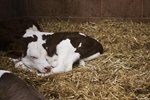
Wet tail refers to a variety of gastrointestinal and urinary issues in rabbits. The term commonly applied to one of the most recognizable symptoms of severe illness in rabbits, literally a wet tail and bottom. It’s important to seek immediate veterinary care if your rabbit’s bottom develops a foul odor or appears wet or dirty.
At-Risk Rabbits
Young weaned rabbits between ages 4 weeks and 10 weeks, and nervous or stressed rabbits, are at higher risk of developing intestinal problems. Newborn rabbits have the antibacterial properties of mother’s milk to protect them; and well-adjusted rabbits older than 10 weeks don’t usually produce excess adrenaline that adversely affects the nervous system and intestines. Though some diarrhea and causes of “wet tail” such as proliferative enteropathy generally resolve themselves in a couple of weeks, you should consider diarrhea life-threatening and make an emergency visit to the vet.
Enterotoxemia
Enterotoxemia primarily affects rabbits between 4 weeks and 8 weeks old. This disease progresses rapidly and can cause death within 48 hours. The characteristic sign of this illness is green-brown explosive diarrhea. Diarrhea is so sudden and severe with this disease that it covers the anal area, giving it a wet appearance. Other symptoms include lethargy and a rough coat.
Tyzzer’s Disease
Tyzzer’s disease targets newly weaned rabbits up to 12 weeks old. This acute bacterial infection causes excessive watery diarrhea, anorexia, dehydration, lethargy and profuse staining of the hindquarters. Immediate veterinary care is important if you suspect your bunny has Tyzzer’s disease, as death can occur in as few as three days.
Mucoid Diarrhea
Mucoid diarrhea is easily indentifiable. A rabbit with this disease will produce telltale mucus-covered feces and diarrhea. She will also appear lethargic, cold and dehydrated. She may lose her appetite, have a bloated stomach or rough coat, and grind her teeth or sit with her feet in her water bowl. This disease in particular can result from environmental stress so it’s important to know your bunny and her limits when it comes to transport and playtime. Avoiding grain or milk pellets, which are associated with toxins known to cause this disease, until bunnies are at least 3 months old may help prevent mucoid diarrhea.
Bladder and Urinary Tract Problems
A wet tail or belly can signal infection in your rabbit’s bladder or urinary tract; she can’t control her urine, so it ends up soaking her. Bladder and urinary tract infections as well as urinary tract obstructions tend to produce the same symptoms: thick, beige or brown-colored urine, frequent, painful or difficult urination, urinating in small amounts and urinary incontinence. She may pee in places she’s never peed before. These infections can cause urine burns around your pet’s hind legs and genitals. Ouch. Peeing outside the litter box is a cry for help. Get it.
References
Photo Credits
-
Michael Blann/Photodisc/Getty Images
Writer Bio
Christina Stephens is a writer from Portland, Ore. whose main areas of focus are pets and animals, travel and literature. A veterinary assistant, she taught English in South Korea and holds a BA in English with cum laude honors from Portland State University.




